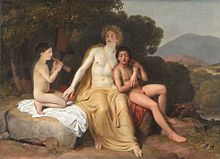Cyparissus


In
Family
According to the grammarian Servius (4th and 5th centuries AD), Cyparissus was the son of Telephus, and thus the grandson of Heracles.[2]
Mythology
As initiation myth

The myth of Cyparissus, like that of
The stag as a gift from Apollo reflects the custom in Archaic Greek society of the older male (erastēs) giving his beloved an animal, an act often alluded to in vase painting.[5] In the initiatory context, the hunt is a supervised preparation for the manly arts of war and a testing ground for behavior, with the stag embodying the gift of the hunter's prey.[6]
Similarly, the myth was used to explain the connection of the cypress tree to mourning and sorrow. Forbes-Irving has argued that the cypress as tree of mourning was mostly a Roman tradition, with few evidence of it playing such a role in Greek society.[7] It is possible however that the earlier Greek source of Cyparissus's myth diverged significantly from the surviving later ones, and was originally used to explain the connection of the cypress to Apollo specifically.[7]
Ovid's version
Ovid frames the tale within the story of Orpheus, whose failure to retrieve his bride Eurydice from the underworld causes him to forsake the love of women in favor of that of boys. When Orpheus plays his lyre, even the trees are moved by the music; in the famous cavalcade of trees that ensues, the position of the cypress at the end prompts a transition to the metamorphosis of Cyparissus.[9]
The commentaries of Servius and the Vatican Mythographer
According to one of the
Silvanus loved a boy (puer) named Cyparissus who had a tame deer. When Silvanus unintentionally killed her, the boy was consumed by sorrow. The lover-god turned him into the tree that has his name, which he is said to carry as a consolation.[13]
It is unclear whether Servius is inventing an
Cyparissus in Phocis
According to a different tradition, a Cyparissus, possibly not the same figure, was the son of
In botany
The word
See also
Notes
- ^ Cedric G. Boulter and Julie L. Bentz, "Fifth-Century Attic Red Figure at Corinth," Hesperia 49.4 (October 1980), pp. 295-308. The authors present a possible identification of Cyparissus on a fragment of a Corinthian pot, No. 36, p. 306. The frescoes in the Pompeiian Fourth Style are discussed by Andreas Rumpf, "Kyparissos", Jahrbuch des Deutschen Archäologischen Instituts 63/64 (1948–49), pp. 83–90.
- .
- ^ Bernard Sergent, Homosexualité dans la mythologie grecque, 1984 (Chapter 2), with an introduction by Georges Dumézil, whose lead Sergent follows.
- Karl Kerenyi, The Gods of the Greeks (Thames and Hudson, 1951), p. 140.
- ^ Gifts of animals from the erastes are discussed as they appear in Attic vase-painting by Gundel Koch-Harnack, Knabenliebe und Tiergeschenke: Ihre Bedeutung im päderastischen Erziehungssystem Athens (Berlin 1983).[page needed]
- ^ Koch-Harnack, Knabenliebe und Tiergeschenke.[page needed]
- ^ ISBN 0-19-814730-9.
- MetamorphosesX 106ff.
- ^ Elaine Fantham, Ovid's Metamorphoses (Oxford University Press, 2004), p. 162.
- ^ Ronald E. Pepin, The Vatican Mythographers, 2008:17
- ^ Virgil, Georgics 1.20: et teneram ab radice ferens, Silvane, cupressum.
- Servius, note to Georgics 1.20 (Latin).
- ^ Hic amavit puerum Cyparissum nomine, qui habebat mansuetissimam cervam. hanc cum Silvanus nescius occidisset, puer est extinctus dolore: quem amator deus in cupressum arborem nominis eius vertit, quam pro solacio portare dicitur.
- ^ Peter F. Dorcey, The Cult of Silvanus: A Study in Roman Folk Religion (Brill, 1992), pp. 15–16. Servius also mentions this version in his note to Eclogue 10.26.
- ^ Servius, note to Aeneid 3.680.
- ^ Ergo cupressi quasi infernae, vel quia succisae non renascuntur, vel quia apud Atticos funestae domus huius fronde velantur.
- ^ Stephanus of Byzantium, s.v. «Aπολλωνία» and «Κυπάρισσος». Real Enzyclopädie VIII, col. 51, s.v. «Kyparissos» [Hirschfeld].
- ^ C. Michael Hogan and Michael P. Frankis. 2009[full citation needed]
References
- Brill’s New Pauly: Encyclopaedia of the Ancient World. Antiquity, Volume 3, Cat-Cyp, editors: Hubert Cancik, Helmuth Schneider, .
- Servius, Servii grammatici qui feruntur in Vergilii carmina commentarii, Volume I, edited by Georgius Thilo and Hermannus Hagen, Bibliotheca Teubneriana, Leipzig, Teubner, 1881. Internet Archive. Online version at the Perseus Digital Library.
External links
 Media related to Cyparissus at Wikimedia Commons
Media related to Cyparissus at Wikimedia Commons

